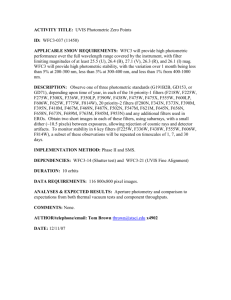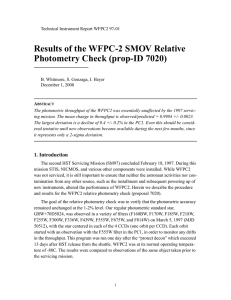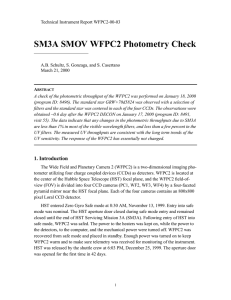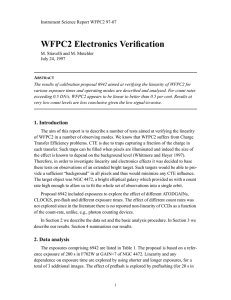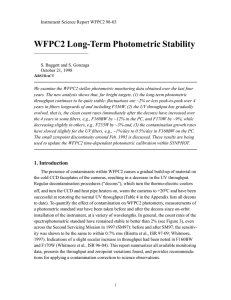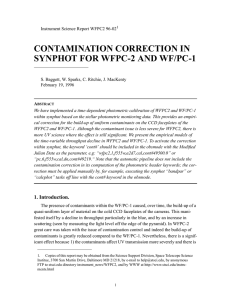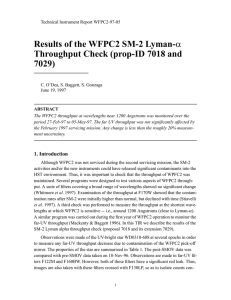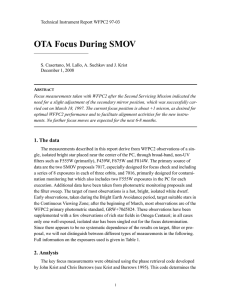SMOV3B WFPC2 Photometry Check
advertisement
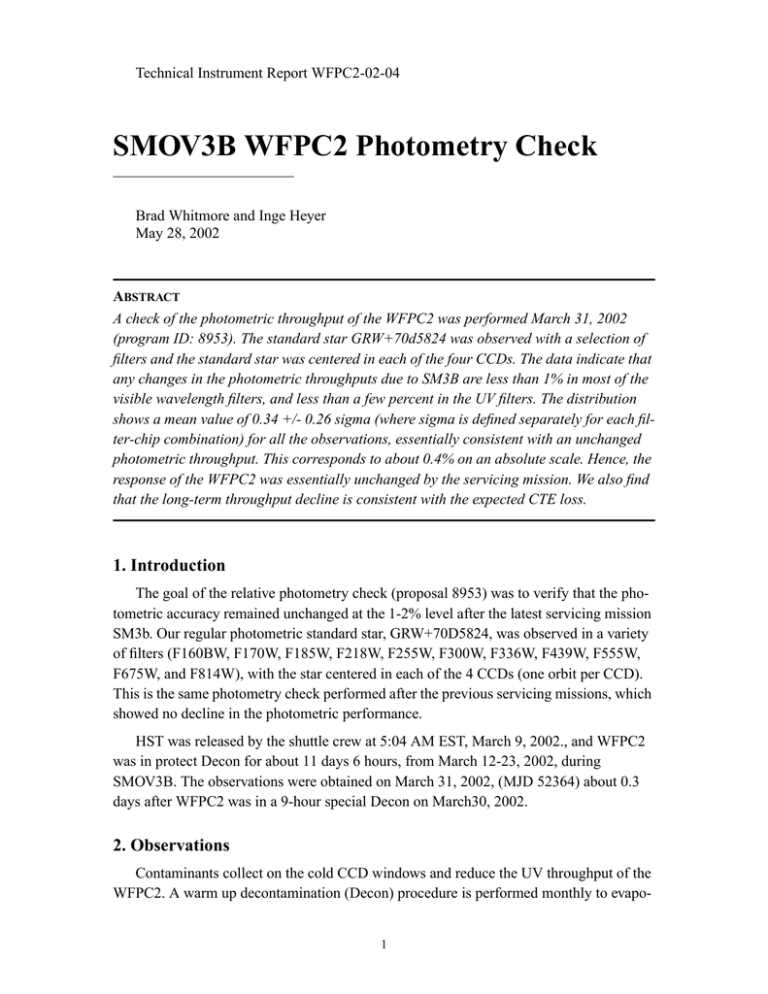
Technical Instrument Report WFPC2-02-04 SMOV3B WFPC2 Photometry Check Brad Whitmore and Inge Heyer May 28, 2002 ABSTRACT A check of the photometric throughput of the WFPC2 was performed March 31, 2002 (program ID: 8953). The standard star GRW+70d5824 was observed with a selection of filters and the standard star was centered in each of the four CCDs. The data indicate that any changes in the photometric throughputs due to SM3B are less than 1% in most of the visible wavelength filters, and less than a few percent in the UV filters. The distribution shows a mean value of 0.34 +/- 0.26 sigma (where sigma is defined separately for each filter-chip combination) for all the observations, essentially consistent with an unchanged photometric throughput. This corresponds to about 0.4% on an absolute scale. Hence, the response of the WFPC2 was essentially unchanged by the servicing mission. We also find that the long-term throughput decline is consistent with the expected CTE loss. 1. Introduction The goal of the relative photometry check (proposal 8953) was to verify that the photometric accuracy remained unchanged at the 1-2% level after the latest servicing mission SM3b. Our regular photometric standard star, GRW+70D5824, was observed in a variety of filters (F160BW, F170W, F185W, F218W, F255W, F300W, F336W, F439W, F555W, F675W, and F814W), with the star centered in each of the 4 CCDs (one orbit per CCD). This is the same photometry check performed after the previous servicing missions, which showed no decline in the photometric performance. HST was released by the shuttle crew at 5:04 AM EST, March 9, 2002., and WFPC2 was in protect Decon for about 11 days 6 hours, from March 12-23, 2002, during SMOV3B. The observations were obtained on March 31, 2002, (MJD 52364) about 0.3 days after WFPC2 was in a 9-hour special Decon on March30, 2002. 2. Observations Contaminants collect on the cold CCD windows and reduce the UV throughput of the WFPC2. A warm up decontamination (Decon) procedure is performed monthly to evapo- 1 rate contaminants from the CCD windows which is followed by a cool down. Following a Decon on March 30, 2002 (MJD=52363.7516), observations were taken for the purpose of determining if any chance in the photometric performance had occurred as a result of SM3B. Observations of standard star GRW+70d5824 (mv = 12.7, B-V = -0.09) for the photometry check were obtained on March 31, 2002 (program ID: 8953) which was approximately 0.3 days following the Decon on March 30, 2002. The star was positioned in the center of a camera during four 1-orbit visits, one visit per camera. The respective single camera images were read out and sent to the ground for analysis. Observations were obtained with filters F160BW, F170W, F185W, F218W, F255W, F300W, F336W, F439W, F555W, F675W, and F814W. Table 1 lists the observations. Table 1. 8953 Photometry Monitor Observations. filter PC1 PC1 exptime (sec.) WF2 WF3 WF4 WF exptime (sec.) F160BW u8bd0101r 200.0 u8bd0201r u8bd0301r u8bd0401r 100.0 F170W u8bd0102r 40.0 u8bd0202r u8bd0302r u8bd0402r 40.0 F185W u8bd0103r 100.0 u8bd0203r u8bd0303r u8bd0403r 100.0 F218W u8bd0104r 40.0 u8bd0204r u8bd0304r u8bd0404r 40.0 F255W u8bd0105r 80.0 u8bd0205r u8bd0305r u8bd0405r 40.0 F300W u8bd0106r 10.0 u8bd0206r u8bd0306r u8bd0406r 10.0 F336W u8bd0107r 14.0 u8bd0207r u8bd0307r u8bd0407r 12.0 F439W u8bd0108r 14.0 u8bd0208r u8bd0308r u8bd0408r 8.0 F555W u8bd0109r 3.5 u8bd0209r u8bd0309r u8bd0409r 2.3 F675W u8bd010ar 8.0 u8bd020ar u8bd030ar u8bd040ar 4.0 F814W u8bd010br 14.0 u8bd020br u8bd030br u8bd040br 7.0 3. Calibration and Data Reduction The OPUS pipeline calibrated data were used for the analysis. No other calibration steps were performed. Photometry was performed using the APPHOT task phot with the star positions automatically identified for each camera as input1. For the PC1 frames, a photometry aperture radius of 11 pixels was used with the sky fitting region parameters set to annulus=32 pix- 2 els and dannulus=11 pixels. For the WF frames, a photometry aperture radius of 5 pixels was used with the sky fitting region parameters set to annulus=15 pixels and dannulus=5 pixels. The sky fitting algorithm was set to “ofilter.” The centering algorithm was set to “centroid”. The photometry values are listed in Tables 2-5. For Tables 2-5, the table headers are: filter - WFPC2 filter used. mjd - modified Julian Date (Julian Date - 2400000.5) for the observation. ct_rate - countrate (DN/s) for the respective aperture. Table 2. PC1 photometry. filter mjd ct_rate F160BW 52364.22 88.301 F170W 52364.23 170.478 F185W 52364.23 92.641 F218W 52364.24 128.388 F255W 52364.24 150.319 F300W 52364.24 941.872 F336W 52364.24 740.793 F439W 52364.24 886.434 F555W 52364.25 3724.889 F675W 52364.25 2063.758 F814W 52364.25 1355.537 filter mjd ct_rate F160BW 52364.29 76.366 F170W 52364.29 192.428 F185W 52364.30 102.416 F218W 52364.30 139.858 F255W 52364.30 159.448 Table 3. WF2 photometry. 1. The scripts used for this work can be found at the following locations: /data/denali11/smov3b/script_smov_8953 (photometry) /data/nerys5/script_library/scripts_smov2002/script_smov_8953_autoplot_*.cl (creating Figures 1-4) /data/denali11/smov3b/script_sigma_diagram (creating Figure 5) data/nerys5/script_library/scripts_smov2002/script_smov_cte_comp_pc1.cl (creating Figure 6) 3 filter mjd ct_rate F300W 52364.30 955.157 F336W 52364.31 756.947 F439W 52364.31 883.425 F555W 52364.31 3726.059 F675W 52364.31 2098.310 F814W 52364.31 1377.432 filter mjd ct_rate F160BW 52364.36 66.767 F170W 52364.36 152.701 F185W 52364.36 82.069 F218W 52364.37 127.220 F255W 52364.37 157.696 F300W 52364.37 959.739 F336W 52364.37 753.756 F439W 52364.38 859.329 F555W 52364.38 3681.950 F675W 52364.38 2036.548 F814W 52364.38 1338.025 filter mjd ct_rate F160BW 52364.09 67.101 F170W 52364.09 167.927 F185W 52364.10 94.994 F218W 52364.10 138.287 F255W 52364.10 157.344 F300W 52364.10 984.035 F336W 52364.11 750.429 F439W 52364.11 865.116 F555W 52364.11 3735.275 Table 4. WF3 photometry. Table 5. WF4 photometry. 4 filter mjd ct_rate F675W 52364.11 2075.017 F814W 52364.11 1363.641 4. The Results The 8953 calibration program executed approximately 0.34 - 0.63 days following the Decon on March 30, 2002. Figure 1 through Figure 4 show the evolution of the photometric measurements from 1995 until the present, for nine filters and all four chips. The star represents the post SM3b data point. The data has been normalized to a mean of 1.0 based on the historical dataset, and fitted from MJD 51000 to the present, with the exception of F675W for PC1 and WF2, which were fitted from MJD 50200 and 50700, respectively, due to the paucity of recent data. The 1-sigma scatter (based on the empirical scatter) of the baseline measurements are shown by dashed lines. The observed long-term trend is a decline of the throughput, to varying degrees in the different filters. The post-SM3b data point seems to follow the most recent trend. The overall data for several UV filters (most notably F255W) seem to show a curious sharp downward trend around MJD 51000, and we are currently investigating possible causes. Figure 5 shows the statistical distribution of the post-SM3b photometry data points around the predicted values based on the fits shown in Figure 1 through Figure 4, and normalized by the 1-sigma error bars shown by the dotted lines. We find that the distribution has a mean value of 0.34 +/- 0.26 sigma for all the observations, hence there is no obvious change in the throughput before and after SM3b. This compares to a value of -0.17 +/0.14 for SM2 (Biretta et al. 1997). The mean value in the PC appears to be slightly higher, with a value of 1.31 +/- 0.56 sigma. However, even this is only about a 2-sigma result, and is probably due to low number statistics. We note that in SM2 a similar 2-sigma result was found for the PC, but in the opposite sense (i.e. a decline instead of an increase). The fact that the width of the distributions in Figure 5 are larger than 1 sigma, suggests that there are other sources of uncertainty besides the historical random uncertainties, such as large fluctuations in focus or breathing. Figure 6 shows the observed throughput decline compared with that predicted from Dolphin’s CTE equations (2001) for F336W, F555W, and F814W. For all three filters the throughput decline is consistent with the expected CTE loss, within the uncertainties. 5 Figure 1: Photometric Throughput for PC1 in 9 filters. The star represents the post-SM3b data point. The data has been normalized to a mean of 1.0 based on the baseline observations, and fitted from MJD 51000 to the present, with the exception of F675W, which was fitted from MJD 50200 due to the paucity of recent data. The 1-sigma scatter (based on the empirical scatter) of the baseline measurements are shown by dashed lines. 6 Figure 2: Same as Figure 1 for WF2. F675W was fitted from MJD 50700 due to the paucity of recent data. 7 Figure 3: Same as Figure 1 for WF3. 8 Figure 4: Same as Figure 1 for WF4. 9 Figure 5: Statistical distribution of the post-SM3b photometry data points (number of data points vs. sigma). 10 Figure 6: Actual throughput (solid lines) vs. expected decline from Dolphin’s CTE equations (dashed lines) for F336W, F555W, and F814W for the PC1 chip. This shows that the long-term trends are due to CTE loss, within the measurement uncertainty. The discontinuity for the early data points for F814W is due to a change in the exposure times. 11 5. Conclusions and Recommendations The WFPC2 calibration program 8953 was executed post-SM3b to check that the relative photometric throughput had not changed. Observations of the standard star GRW+70D582 were obtained with each camera and with the normal selection of monitor filters (11 filters). Each camera performed as expected, and WFPC2 was unaffected by the SM3b Servicing Mission. The distribution shows a mean value of 0.34 +/- 0.26 sigma for all the observations, consistent with an unchanged photometric throughput. Hence, the response of the WFPC2 was essentially unchanged by the servicing mission. We also find that the long-term throughput decline is consistent with the expected CTE loss. 6. References Baggett, S. and Gonzaga, S. 1998, WFPC2 Long-Term Photometric Stability, WFPC2ISR-98-03. (http://www.stsci.edu/instruments/wfpc2/Wfpc2_isr/wfpc2_isr9803.html) Biretta J., Heyer I., Baggett S., et al. 1997, Results of the WFPC2 Post-Servicing Mission-2 Calibration Program, WFPC2-ISR-97-09. (http://www.stsci.edu/instruments/wfpc2/ Wfpc2_isr/wfpc2_isr9709.html) Biretta J., McMaster M., Baggett S., and Gonzaga S. 1997, Summary of WFPC2 SM97 Plans, WFPC2-ISR-97-03. (http://www.stsci.edu/instruments/wfpc2/Wfpc2_isr/ wfpc2_isr9703.html) Casertano, S., et al., editors, The 1997 HST Calibration Workshop Proceedings, STScI, 1998, p.318. (http://www.stsci.edu/stsci/meetings/cal97/proceedings.html) Dolphin, A. E. 2001 (April 2), private communication, http://www.noao.edu/staff/dolphin/wfpc2_calib/ Gonzaga, S., Ritchie, C., Baggett, S., Casertano, S., Whitmore, B., and Mutchler, M. 2000, “Standard Star Monitoring Memo”, (http://www.stsci.edu/instruments/wfpc2/ Wfpc2_memos/wfpc2_stdstar_phot3.html) 12
